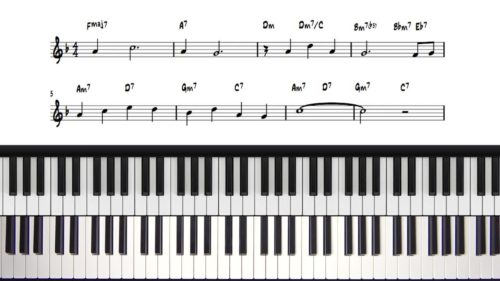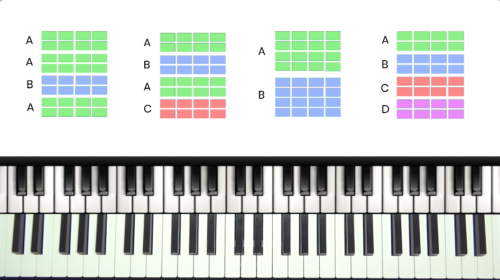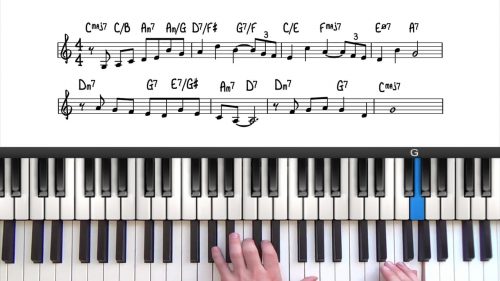“Moon River” – The C Section
Welcome to our 3rd lesson on the jazz standard “Moon River” for beginners. So far in this course we have covered the 1st 16 bars of the tune which is also known as the A and B sections.
In this lesson we will add the final section, the C section, we will deepen our understanding of these terms, and we will consolidate the overall structure and form of “Moon River”.
The Structure & Form Of Lead Sheets
Lead sheets from the Great American Songbook most commonly follow a 32-bar form and are divided into four sections. The tune “Moon River” can be broken down into 4 sections: the A section, the B section, the 2nd A section, & the C section.
We observe that bars 17-24 (2nd A section) are identical to the 1st 8 bars (1st A section) and this is a common feature of jazz standards. Understanding this repetition helps us to reduce the amount of information we need to memorise the song in its entirety.
C Section Chord Voicings
We apply chord voicings and arranging techniques to the C section of “Moon River” (bars 25-38). It’s important to understand that the C section for ‘Moon River’ is 14 bars long, unlike the previous sections which are all 8 bars long.
We focus on playing simple chord voicings and we examine the role of ‘slash chords’ which are commonly used to create smoother transitions between the chords.
We stress the importance of visualising the different sections to keep track of our position in the song. We finish by playing through the entire tune, indicating when we change sections to reinforce this understanding.
Practice Tips
-
Use the repetitive structure of jazz standards to your advantage in memorising the form and visualising the repeating sections. This greatly speeds up the memorisation process.
-
Understand that slash chords such as A-7/G are most often used to imply a specific bass line movement, in this case connecting A-7 to F#-7b5 in bars 25 to 27.
-
Make sure that you are comfortable with these basic spread voicings before moving onto the next module where we introduce lower bass notes, chord extensions, and melodic embellishment.







There’s so much info in just these three lessons and I’m having lots of fun trying to decipher/practice everything. Thank you for your clear and well guided instructions
Hi there, amazing lesson ! I do have a question on the bars 6 & 7 of this section, are the B7 and the A7 on the second part of the beat 1, or are they on th beat 2 ? Thanks !
Hi there, amazing lesson ! I do have a question on the bars 6 & 7 of this section, are the B7 and the A7 on the second part of the beat 1, or are they on th beat 2 ? Thanks ! (i think this post belonged in the section B part of this lesson)
Hi Guillaume,
Yes I play the B7 and the A7 on beat 2 of the bar.
I’m sure there are other ways to do this, but that’s how I like to play it.
I count 1-&-2-&-3-& and notice that my left hand plays on beat 1, and also I ‘stab’ my thumb on the & of 1, and I find this helps me to keep the time solid. Watch the video at 9:20 to 9:25 and look at my left hand.
I hope that helps and I’m glad you are enjoying the lessons!
Have a great weekend and talk soon.
Cheers,
Hayden
Around the 4:40 mark, when discussing the Am/G in bar 26. Is the norm to replace the root with the bass note of the slash chord? I figured it would just mean playing an inversion (I would’ve expected it to read C/G with the notes played in the video). Or is it that in this case, with both the G and A so low in the register, it’d sound too muddy so you just make a judgement call to omit the A and prioritise the falling bass note throughout the progression?
Thanks again for all the videos! Great to hear your methods on how you decide to work through lead sheets like these.
Hi Mick,
Great question.
Yes in this case I would see this as replacing the root with the minor 7th, which is G. This is a common movement for minor chords and you can see more here: pianogroove.com/jazz-piano-lessons/the-minor-line-cliche-tutorial/
In the Moon River arrangement, we are using the A-/G to create a smooth bass note transition to F#-7b5 in the next bar.
You are correct that if we play the A- triad to A-/G in the lower registers it will sound muddy, so in that case I would probably just stick on the A-7 chord. Alternatively we could just play the bass notes A and G descending, but for my ears I prefer the A- triad to A-/G in the middle register.
A-/G can also be seen as A-7 but with the 7th in the bass and the root omitted. Check out the lesson referenced above for more information.
Talk soon,
Hayden
p.s. thanks for the feedback and I’m really glad you are enjoying the lessons.
Awesome, really appreciate the clarification there Hayden. I haven’t checked out the line cliche video, but will do so now!
My pleasure, Mick.
If you have any further questions don’t hesitate to get in touch.
Talk soon,
Hayden